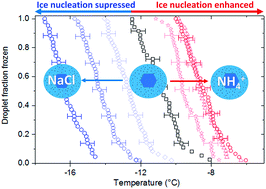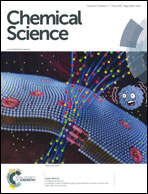The enhancement and suppression of immersion mode heterogeneous ice-nucleation by solutes
Abstract
Heterogeneous nucleation of ice from aqueous solutions is an important yet poorly understood process in multiple fields, not least the atmospheric sciences where it impacts the formation and properties of clouds. In the atmosphere ice-nucleating particles are usually, if not always, mixed with soluble material. However, the impact of this soluble material on ice nucleation is poorly understood. In the atmospheric community the current paradigm for freezing under mixed phase cloud conditions is that dilute solutions will not influence heterogeneous freezing. By testing combinations of nucleators and solute molecules we have demonstrated that 0.015 M solutions (predicted melting point depression <0.1 °C) of several ammonium salts can cause suspended particles of feldspars and quartz to nucleate ice up to around 3 °C warmer than they do in pure water. In contrast, dilute solutions of certain alkali metal halides can dramatically depress freezing points for the same nucleators. At 0.015 M, solutes can enhance or deactivate the ice-nucleating ability of a microcline feldspar across a range of more than 10 °C, which corresponds to a change in active site density of more than a factor of 105. This concentration was chosen for a survey across multiple solutes–nucleant combinations since it had a minimal colligative impact on freezing and is relevant for activating cloud droplets. Other nucleators, for instance a silica gel, are unaffected by these ‘solute effects’, to within experimental uncertainty. This split in response to the presence of solutes indicates that different mechanisms of ice nucleation occur on the different nucleators or that surface modification of relevance to ice nucleation proceeds in different ways for different nucleators. These solute effects on immersion mode ice nucleation may be of importance in the atmosphere as sea salt and ammonium sulphate are common cloud condensation nuclei (CCN) for cloud droplets and are internally mixed with ice-nucleating particles in mixed-phase clouds. In addition, we propose a pathway dependence where activation of CCN at low temperatures might lead to enhanced ice formation relative to pathways where CCN activation occurs at higher temperatures prior to cooling to nucleation temperature.

- This article is part of the themed collections: Most popular 2018-2019 physical and theoretical chemistry articles and 2018 ChemSci Pick of the Week Collection


 Please wait while we load your content...
Please wait while we load your content...